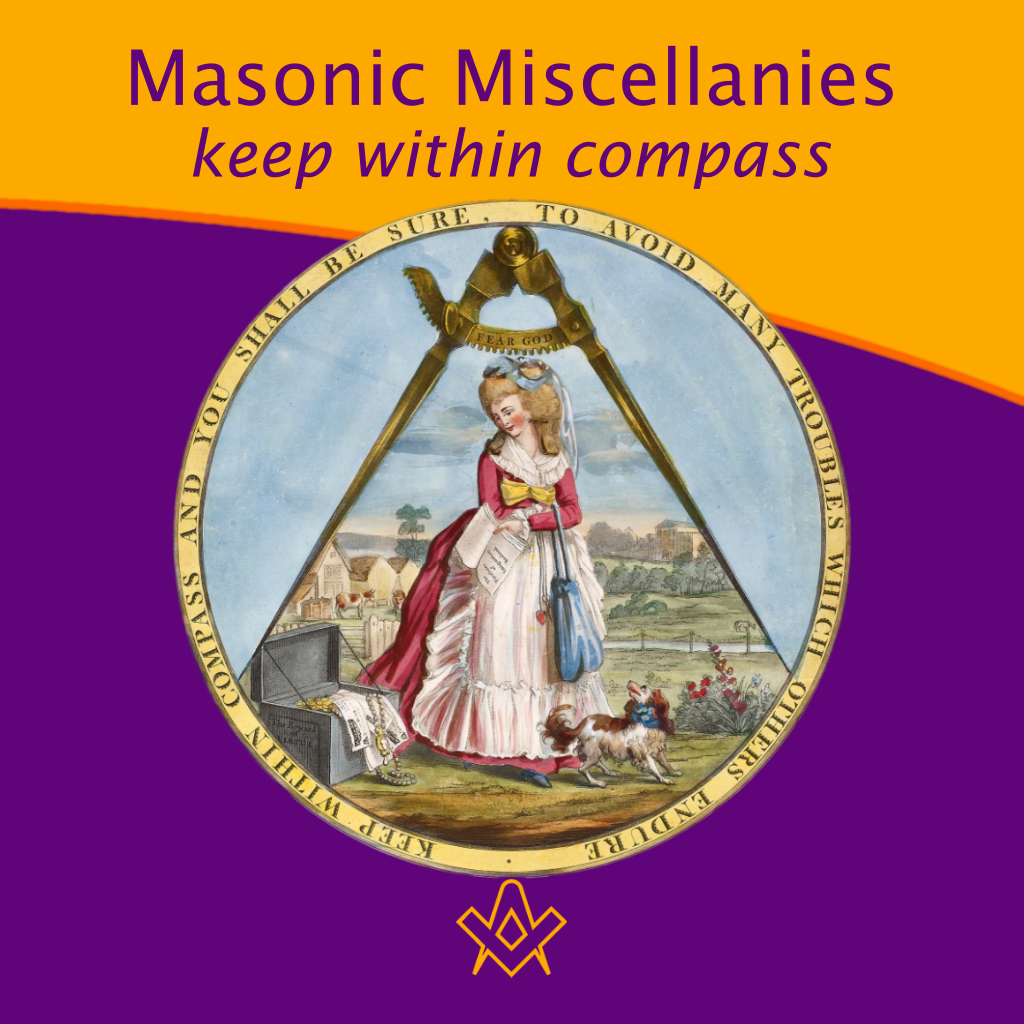“Keep within Compass and you shall be sure, to avoid many troubles which others endure.”
I discovered this rather fascinating series of allegorical Masonic-inspired morality prints and decided to do some digging into the origins and meaning.
There are several variations but all were designed to convey a moral or “cautionary” tale for those who may be prone to straying from the path.

I found this initial design and description on the excellent ‘In the Words of Women‘ blog:
You may be somewhat perplexed by the above print which often appeared as a model for women during the eighteenth century.
It utilizes a compass, a Masonic symbol, an emblem of virtue representing restraint and self-control, to illustrate a lesson in conduct.
The ideal woman of that time was supposed to stay within the bounds circumscribed by the compass and “Enter not into the way of the wicked and go not in the path of evil men.”
At the corners of the print are behaviors of “fallen” women. In the upper left a mother is not caring for her child properly; the infant appears to be slipping from her lap.
In the top right a woman is shown working in a tavern. In the lower left a woman is standing in a street selling things to make money. In the lower right we see a prostitute soliciting some men.
All of these activities are, it is suggested, inappropriate and demeaning for a woman. The reward for behaving “properly” is written around the circle: “Keep within compass and you shall be sure to avoid many troubles that others endure.”
In addition to proscribing certain behaviors on the part of women the illustration describes the appropriate relationship between husband and wife: in a marriage the woman should tend to the family and depend on the man to work and provide for them; her role is to be the “Virtuous Woman” and “a Crown to her Husband.”
For teachers among this blog’s readers, this print could be the basis for an interesting lesson on the role of women in the eighteenth century.
The illustration is a contemporary English print published between 1785 and 1805, engraved by Robert Dighton, and published by Carington Bowles. It is at the Winterthur Museum.
– Written by Janet M. Wedge POST from 24 APRIL, 2014
The Carington Bowles / Robert Dighton Prints
Printmaker and publisher Carington Bowles (1724-1793) made the following version of the prints available via his firm “Bowles & Carver”, 69 St. Paul’s Church Yard, London.
Robert Dighton was the “anonymous” artist. Dighton was a caricaturist, painter, printmaker, and singer. He worked for Carington Bowles, supplying mezzotints for Bowles’ publications.
He became successful in his own right and opened a shop in the early 1800s selling his own prints and those of others – it was later discovered that many of these prints had been stolen from the British Museum!
He produced the versions of “Keep within the Compass” below, now held (ironically) within the collection at the British Museum.

Self-portrait. By Robert Dighton – https://www.abbottandholder-thelist.co.uk/
IMAGE LINKED: wikimedia Attribution 4.0 International (CC BY 4.0)
“Keep Within Compass – Prudence Produceth Esteem”

“Keep within Compass”, Robert Dighton, 1785 © The Trustees of the British Museum
IMAGE LINKED: British Museum Attribution 4.0 International (CC BY 4.0)
“Keep within Compass”; lady standing in a garden, holding a book, and contemplates an open chest filled with bank notes and gold, a spaniel at her feet looks up, in the background wooded grounds with a mansion at the top of a hill and farm below, a pair of compasses frames the scene set within a circle, at each corner are depicted the miseries of vice. Pen and grey ink and grey wash. Preparatory drawing for the anonymous mezzotint published by Carington Bowles, 1785.
– Source: the British Museum

(After) Robert Dighton, Bowles and Carver, London 1785.
IMAGE LINKED: British Museum Attribution 4.0 International (CC BY 4.0)
A companion print to BMSat 6903. A young woman stands within a compass inscribed ‘Fear God’, holding an open book inscribed ‘The Pleasures of Imagination Realized’.
At her feet is an open chest full of guineas from which hang bank-notes and jewels; it is inscribed ‘The Reward of Virtue’. A small dog stands beside her.
In the background (right) is a country house, on the left farm-buildings and haystacks. The four corners are filled (as in BMSat 6903) with the disasters which beset the woman who does not ‘keep within compass’.
(1) A woman weeps dejectedly with cards and an empty purse on the ground at her feet.
(2) A drunken woman lets an infant fall from her arms; on the wall is a torn print inscribed ‘Domestic Happiness’.
(3) A woman is being conducted to the watch-house by two watchmen, one with his lantern, the other with a rattle.
(4) She beats hemp in Bridewell, a man standing behind her with a whip, as in Hogarth’s ‘Harlot’s Progress’.
The words round the circle are the same as in BMSat 6903. Beneath the circle is inscribed ‘Prudence produceth esteem’. Below the design four verses are engraved, the first:
‘Instead of Cards my Fair-one look,
(I beg you’ll take it kind)
Into some learned Author’s Book,
And cultivate your mind.’ 1785
Mezzotint with hand-colouring
– Source: the British Museum collection BMSat 6907:

(After) Robert Dighton, Bowles and Carver, London 1785..
IMAGE LINKED: British Museum Attribution 4.0 International (CC BY 4.0)
A companion print to BMSat 6907. Design in a circle inset in an oblong. A compass, inscribed ‘Fear God’, its legs forming arcs of the circle, encloses the figure of a young man standing in a rural landscape; he points with his left hand to two sacks full of guineas at his feet.
In the background is a harvest scene (left), a stream with a water-wheel (right), and in the distance a church (right) and windmill (left).
Round the circle is inscribed ‘Keep within compass and you shall be sure, to avoid many troubles which others endure’.
Beneath the circle, ‘Industry Produceth Wealth’. Beneath the design are four verses, the last:
‘By honest & Industrious means
You’ll live a life of ease
Then let the Compass be your guide
And go where e’er you please.’In the four corners of the oblong outside the circle are scenes showing the fatal results of an unrestrained life.
(1) In the upper left corner a gambler is seated by a circular table on which are cards, dice, and an empty moneybag; he puts his hand to his forehead with a distraught expression. On the wall behind his head hang two pistols and through a window is seen a body hanging from a gibbet.
(2) In the upper right corner a courtesan robs a young man who is in a drunken sleep; bottles and glasses are on a table.
(3) In the lower left corner a ship drives upon rocks.
(4) In the lower right corner three prisoners are seen through a barred window; on the wall is a pair of shackles. c.1785
Mezzotint with hand-colouring
– Source: the British Museum collection BMSat6903

Keep Within Compass and you Shall Be Sure, To Escape Many Troubles that Others Endure.
c.1820 (undated)
IMAGE LINKED: wikimedia Attribution 4.0 International (CC BY 4.0)
And if you fancy owning a later version by William Darton, this very rare broadside is for sale via Geographicus Rare Antique Maps https://www.geographicus.com/P/AntiqueMap/masonicallegory-darton-1820
An unusual and rare c. 1820 William Darton masonic allegorical broadside intended to promote the masonic virtues of self-restraint and balance.
Unlike most allegorical educational broadsides of the period that illustrate both men and women, this production by Darton emphasizes no particular difference between the path of virtue for women vs. men.
Both the male and female medallions are situated within the compass, a central Masonic symbol characterizing restraint, and illustrate individuals of both humility and means.
At the feet of both are sacks/chests full of bullion, suggesting wealth, while to their left are domesticated animals, an Irish wolfhound for the man, and chickens for the woman. Behind each are prosperous country homes.
The figures are surrounded by tidbits of wisdom, some drawn from Biblical sources:
Sacrifice not they Conscience for Money.
Spare when Young, and Spend when old.
He that Goes a Borrowing Goes a Sorrowing.
etc…Variant forms of these images appear in England and North America from roughly the mid-18th century.
This example, from the 19th century is late, but distinctive as coming from the workshop of Print and Map Seller, and Freemason, William Darton. Examples of this broadside are today quite rare.
– Source: Geographicus.com
Recent Articles: Masonic Miscellanies
 Masonic Miscellanies - The Amulet of the Ladder Explore the cosmic significance of the Ladder in ancient Egyptian mythology through Wallis Budge's "Egyptian Magic." Discover how this profound symbol bridges the mortal and divine, encapsulating the Egyptians' fervent afterlife aspirations with a blend of myth, magic, and material culture. Dive into the celestial ascent of Osiris and mortal souls. |
 Masonic Miscellanies - Adulterine Gilds Guilds, the associations that shaped medieval European society, were more than just organizations of artisans and merchants. They played a vital role in the economic and social development of towns and cities. This exploration delves into the intriguing concept of adulterine gilds and their interconnectedness with guilds, offering insight into the significance of legal authorization and recognition in medieval Europe. |
 Masonic Miscellanies - Masonic Orb Discover the fascinating world of Masonic ball watch fobs, intricately crafted with tiny pyramids that form a cross when opened. These decorative accessories were all the rage in the late 1800s and early 1900s, and they still hold a certain allure today. Explore the different varieties and symbols found on these unique pieces that carry deep Masonic meaning. |
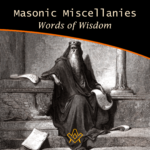 Masonic Miscellanies – Words of Wisdom Uncover timeless wisdom from King Solomon to Albert Pike in our latest Masonic Miscellanies, a treasure trove of insights for Masons. Journey through the ages and glean inspiring sayings, reflecting on their profound influence on Masonic principles. An enriching read for the enlightened. |
 Masonic Miscellanies - Symbolism of the Right Hand Unlock the enigmatic realm of Freemasonry as we delve into its age-old symbols, rituals, and philosophies. This thought-provoking exploration, drawn from Mackey's Revised Encyclopedia of Freemasonry, focuses on the iconic 'right hand' symbol - its rich history, universality, and profound significance. |
 Masonic Miscellanies - Order of the Secret Monitor Unveil the mystery of Freemasonry with 'The Order of the Secret Monitor'. Discover this lesser-known appendant order, its unique rituals, and the profound teachings it offers. Explore the bonds of friendship and brotherhood it fosters, all wrapped in an intriguing cloak of mystery. Your journey into the depths of Masonic wisdom begins here. |
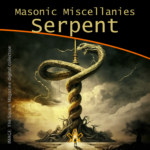 Masonic Miscellanies - The Symbol of the Serpent As a symbol, the serpent obtained a prominent place in all the ancient initiations and religions. |
 Masonic Miscellanies - The Four Veils in Royal Arch Masonry What are the four veils in Royal Arch Masonry? And what is the 'Ceremony of Passing the Veils'? Although common throughout Scotland, Ireland and the United States, it is mostly unknown in England, presently only worked in the Province of Bristol. ( and by dispensation ) |
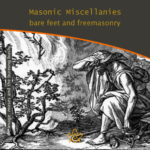 Masonic Miscellanies - Bare feet and Freemasonry A candidate for initiation into a Masonic Lodge often finds the requirements which he/she must fulfil somewhat odd. The mode of preparation often remains a puzzle, since the ritualistic explanation is not offered in full. Why are we 'slipshod' or "bare-footed" in Masonic Ritual? |
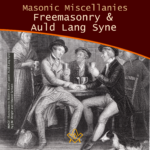 Masonic Miscellanies – Freemasonry and Auld Lang Syne Millions of people throughout the world will sing Auld Lang Syne to see out the Old Year. Few will know all the words, fewer still know what they mean, or that there is a link to Freemasonry. |
 Masonic Miscellanies - The Mosaic Pavement - why mosaic, why pavement? We are all familiar with the black and white chequered flooring of the Masonic lodge but where did it originate? There are a few theories… |
 Masonic Miscellanies – Masonic Master's Carpets Have you got a magic "Masonic Master's Carpet" in your lodge? I say 'magic' with my tongue firmly in my cheek because (as far as I know) these fabulous works of art don't bestow any mystical powers but can bestow some educational ones! However, considering their possible value today, they may magic up some interest (or funds). |
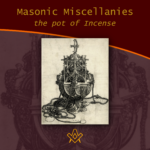 Masonic Miscellanies – The Pot of Incense Just when the pot of incense became an emblem of the third section of the Sublime Degree can not be stated with certainty. It is, apparently, an American invention or addition. But what does it symbolise? |
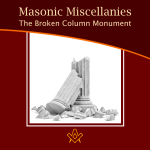 Masonic Miscellanies - The Broken Column Monument The story of the broken column was first illustrated by Amos Doolittle in the "True Masonic Chart" by Jeremy Cross, published in 1819. |
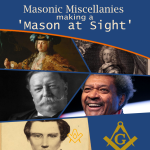 Masonic Miscellanies - Making a 'Mason at Sight' What does it mean to make a 'Mason at sight', and who was made one? |
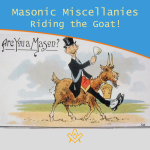 Masonic Miscellanies - Riding the Goat! Many Freemasons will have come across the phrase 'riding the goat', and will no doubt have been the butt of a joke about it (sorry, I couldn't resist!) But what does it mean and where did the phrase come from? |
 Masonic Miscellanies - What are the 'three dots'? Three dots or points in an upright triangular shape ∴ is most commonly known as the 'therefore' sign – so why is it used in Freemasonry? |
 Masonic Miscellanies - Keep Within Compass This month we discover a series of allegorical prints warning us to "Keep within Compass and you shall be sure, to avoid many troubles which others endure." |
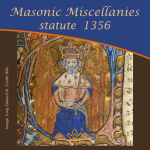 Masonic Miscellanies - statute 1356 Further to the reference in the article – The Builders - 6 - Free-Masons 'a statute was enacted against the Free-masons in 1356' – Regulations for masons who are hewers, on the one hand, and the light masons and setters on the other. |
 Masonic Miscellanies - An Anti-Masonic 'Apron'? The Anti-Masonic 'Apron' was created during the 1832 Presidential election in USA. It was not Ani-masonic. And it was not an apron. Read on to find out what and why it was created. |
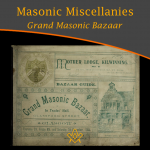 Masonic Miscellanies - Grand Masonic Bazaar (1895) Grand Masonic Bazaar (1895); to raise funds to clear the debt incurred by “Mother Kilwinning” in rebuilding their Lodge. |
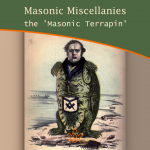 Masonic Miscellanies - the 'Masonic Terrapin' A satirical book from 1851 includes a bizarre caricature of a 'Masonic Terrapin' - all I can say is 'read on'… |
 Masonic Miscellanies - Masonic Bookplates You probably know what a bookplate is for, but did you know that the earliest known book mark/label dates from the reign of Amenhotep III in Egypt around 1391−1353 BCE?! |
 Masonic Miscellanies - Freemasonry & Bees Freemasonry & Bees - what's the buzz? The bee was among the Egyptians the symbol of an obedient people, because, says Horapollo, of all insects, the bee alone had a king. |
 Masonic Miscellanies - The mystery of the Tattooed Freemason In 1894, the body of a drowned man was found in the Bay of San Francisco - what they discovered was amazing. |
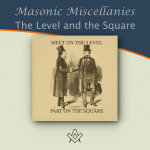 Masonic Miscellanies - The Level and the Square (A Poem) The Level and the Square (A Poem) - "We meet upon the Level, and we part upon the Square – |
 Masonic Miscellanies - The Mystic Tie What is the 'Mystic Tie'? Clue: it's not an item of neckwear! |
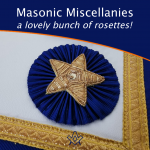 Masonic Miscellanies - A lovely bunch of rosettes! Where did the origin of the use of rosettes on Masonic aprons come from ? |
 Masonic Miscellanies - The Lodge of Sorrow The Lodge of Sorrow - Extracted General Ahiman Rezon, by Daniel Sickles, [1868] |
 Masonic Miscellanies - Memento Mori Memento Mori - a Masonic reminder to make your mark on the world |
 Masonic Miscellanies - A closer look at the Level and the Plumb-rule A closer look at the Level and the Plumb-rule |
 Masonic Miscellanies - The Symbolism of the Gloves The Symbolism of the Gloves and why Freemasons wear white gloves |
 Masonic Miscellanies - Will the real James Anderson please stand up? Will the real James Anderson please stand up? |
 Masonic Miscellanies - The Legend of the Third Degree The most important and significant of the legendary symbols of Freemasonry is, undoubtedly, that which relates to the fate of Hiram Abif. |
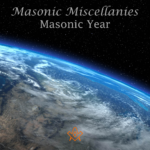 Masonic Miscellanies - Masonic Calendar Why do Freemasons use different 'years' to our regular calendar? |
 Masonic Miscellanies - What is a 'Lewis'? The English word 'Lewis' is a term belonging to operative Masonry, and signifies an iron cramp, which is inserted in a cavity prepared for the purpose in a large stone. |
 Masonic Miscellanies - From J.S.M. Ward Ever wondered why masons had to be 'free' or why we have a Tyler? |
masonic knowledge
to be a better citizen of the world
share the square with two brothers

click image to open email app on mobile device



